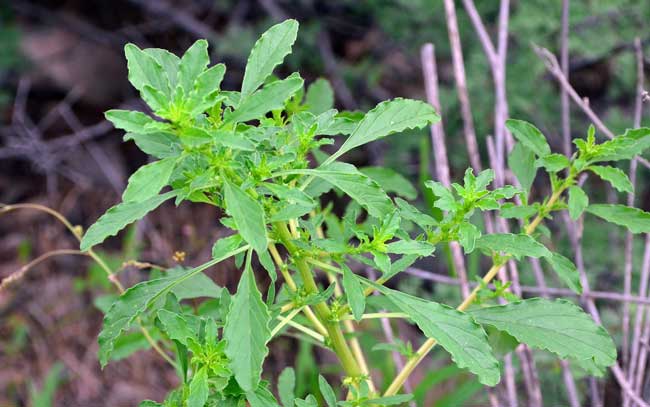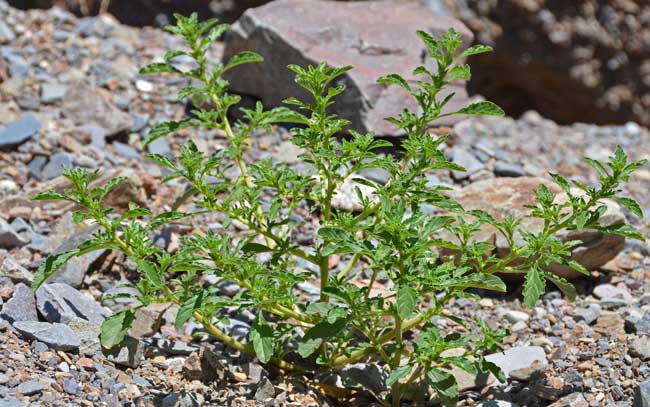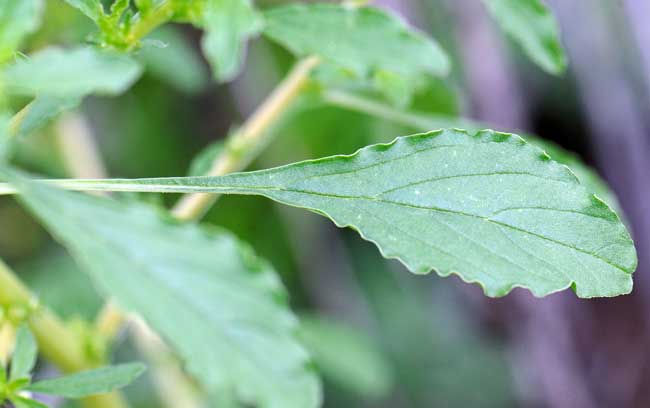Amaranthus albus, Prostrate Pigweed



Scientific Name: Amaranthus albus
Common Name: Prostrate Pigweed
Also Called: Tumbleweed Pigweed, Pigweed, Pigweed Amaranth, Tumble Pigweed, Tumbleweed, White Pigweed
Family: Amaranthaceae, Pigweed Family
Synonyms: (Amaranthus albus var. pubescens, Amaranthus graecizans subsp. sylvestris, Amaranthus graecizans var. pubescens, Amaranthus pubescens)
Status: Introduced
Duration: Annual
Size: Up to 3 feet or more.
Growth Form: Forb/herb; erect, bushy, spiny, smooth whitish or yellowish stems with multiple branches, plants monecious or dioecious.
Leaves: Light green; lighter or whitish beneath, alternate, stem leaves with longer petioles than leaves on the branches, leaves linear or ovate.
Flower Color: Green, whitish-green or yellow; tiny inconspicuous flowers, flowers subtended by linear stiff bracts, flower consists of 3 sepals (no petals), inflorescence a cyme with spike-like clusters from leaf axils, wind pollinated, seeds brown or black.
Flowering Season: Summer
Elevation: 1,500 to 8,000 feet.
Habitat Preferences: Disturbed habitats, roadsides, open areas, along riparian and agricultural areas.
Recorded Range: Over most of North America including Alaska and Mexico. Throughout most of Arizona. In Canada, Prostrate Pigweed is an ephemeral introduction and not persistently naturalized. It has been introduced in South America, Eurasia, Africa and Australia.
North America & US County Distribution Map for Amaranthus albus.
U.S. Weed Information: Amaranthus albus is listed in: Weeds of the Northeast, Weeds of Nebraska and the Great Plains, Weeds of the United States and Canada, and Weeds of the West. Plants included here may become weedy or invasive.
Invasive/Noxious Weed Information: No data available.
Wetland Indicator: Amaranthus albus is on the USDA 2012 National Wetland Plant List as a facultative species, i.e., usually occurs in non-wetlands, but may occur in wetlands.
Threatened/Endangered Information: No data available.
In the Southwestern United States: Arizona has 19 species of genus, California has 18 species, Nevada has 9 species, New Mexico has 19 species, Texas has 26 species, Utah has 12 species. All data approximate and subject to revision.
Comments: Prostrate Pigweed is common in Arizona. Its seeds which are scattered about are a food source for doves, quail and other birds. The dried plant readily breaks free and is blown around or "tumbled" by the wind thus dispersing the seeds.
In Southwest Desert Flora also see: Fringed Amaranth, Amaranthus fimbriatus and Carelessweed, Amaranthus palmeri.
Species of the genus Amaranthus are generally referred to as "Pigweeds" and some people are allergic to their pollen which can cause hay fever. Prostrate Pigweed seeds are used for food or ground to make bread and cake. See other ethno-botanical uses at Native American Ethnobotany, University of Michigan, Dearborn.

